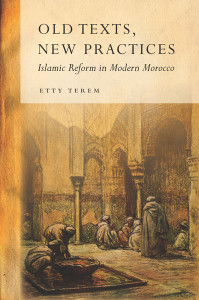|
Reviewed by Cynthia Scheopner, J.D., Senior Researcher, University of Hawaii A massive collection of legal opinions serves as both a window into a time of challenge and change for Morocco, and a reflection upon how the era is considered in contemporary scholarship. Etty Terem provides a comprehensive biography of al-Mahdiī al- Wazzānī and skillfully situates his al-Mi‘yār al-jadid in historical and political context, before describing specific legal opinions and their societal significance. This first scholarly engagement with the work also points to areas still in need of critical analysis. It is so well-written and presented that it prompts the wish for a few tools to assist either readers new to this subject, or sophisticated readers seeking to draw their own conclusions. This limitation makes the book most accessible to scholars who have a moderate familiarity with Islamic law, literature, or history. al-Mi‘yār al-jadid (translated as the New Standard Measure) is an eleven-volume compilation of Mālikī fatwās published in 1910. Terem pieces together a comprehensive biography of al-Wazzānī (1849-1923) from many historical sources, at times drawing from what is known about contemporaries to surmise the details of his boyhood activities or early education. The details of his advanced education are extensive, with lists of his prominent teachers by name, the subjects and specific works studied, the curriculum and method of instruction, and even anecdotes. (It seems that al-Wazzānī was such a dedicated student, he was known to set his turban on fire while studying at night by oil lamp.) The book is strongest when Terem gives al-Wazzānī his voice, such as in his defense of Moroccan Sufi practices as Islamic. She shows him to be a legal scholar not only well-grounded in tradition, but also responsive to the social and cultural influences of the times. As such, his opinion was highly-valued and his fatwās were influential. This competence and prestige allowed him to evaluate the significance of previous fatwās when creating his massive legal compilation. The New Mi‘yār, then, is more than a convenient catalog or attempt at historical preservation. With it, Terem argues, al-Wazzānī sought to both transmit and re-create Mālikī legal tradition at a time when all Islamic authority was under pressure from European influence. Another strength of the book is as a well-documented challenge to contemporary scholars who view Islamic reformists of the late nineteenth and early twentieth centuries as uniformly rejecting the traditional legal schools. In al-Wazzānī, Terem finds an attempt to reform from within the tradition, adapting Mālikī resources to current societal challenges and thereby, revitalizing the school and claiming continued validity for its authority. His work stands as a contrast to other writers of the time and evidences the need for a more nuanced contemporary scholarly examination that pays attention to how and where reformists engaged with their respective communities. The final chapters of the book describe specific subjects addressed by fatwas in the New Mi‘yār. Terem groups them by theme and in each, she provides historical and social context before addressing the specific ruling. The chapter on gender and family considers fatwas dealing with the ability of women and daughters to inherit from a family endowment, and the proper support of a wife by her husband. In each case, Terem explains the Islamic customary practice and how it was being changed by societal forces. While other judges had ruled in ways unfavorable to women, al-Wazzānī was able to reach a more just result through a different interpretation of Mālikī precedent. While Terem describes its contents generally, legal scholars would like to see an appendix with a listing of the fatwās, or a table of contents, if one exists, especially since she has done such extensive scholarship on the work. An example of a translated fatwā in its entirety would also allow an analysis of the style of legal reasoning and appeal to precedent. In contrast, a novice reader would benefit from a brief description of the Islamic legal schools, of which Mālikī is one example, and a glossary of commonly-referenced terms. For example, throughout the book, many terms critical to an understanding of Islamic law are listed with a one-word translation. A glossary with more complete definitions, and a sense of how the terms interrelate, would be a much-appreciated aid to many readers. With this work, Terem introduces al-Wazzānī into contemporary discussions of Islamic reform, using the New Mi‘yār as an example of how he brought Mālikī legal reasoning into the new century. As an introduction, it invites further exploration and engagement with al-Wazzānī and pre-colonial legal theory in Morocco. |


 Old Texts, New Practices: Islamic Reform in Modern Morocco
Old Texts, New Practices: Islamic Reform in Modern Morocco